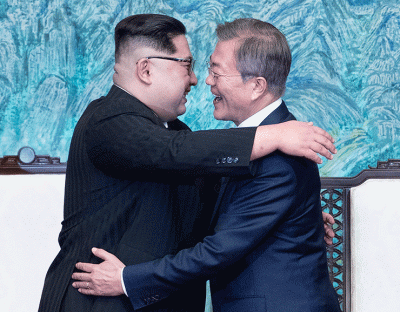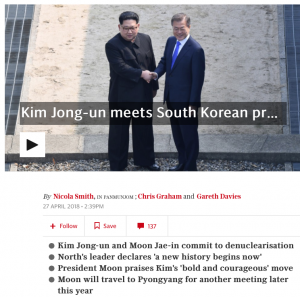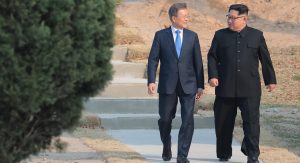North and South Korea: A Handshake that Shook the World

Featured image: South Korean President Moon Jae-in and North Korean leader Kim Jong-un embrace each other after releasing a joint statement at the truce village of Panmunjeom, Friday. (Source: Korea Summit Press Pool)
One of the memorable events of the Summit of Moon Jae-in and Kim Jong-un was the unexpected impact of the historical handshake between the two leaders. Many would agree with me that the Kim-Moon handshake shook the world. But I am asking this: “Did the handshake make the summit a success?” This paper tackles this question.
The Kim-Moon Handshake
Early morning of April 27, 2018, the world saw Kim Jong-un coming with dignity and self confidence toward Moon Jae-in who was waiting on the south side of the narrow demarcation line separating the Korean peninsula into two parts.. As soon as Kim approached Moon, the two leaders greeted each other with sincere and friendly smile and they shook hands with enthusiasm.
It was, in a way, the handshake of two giant families: the family of fifty million members of South Korea with the family of twenty-five million members of North Korea; it meant the meeting of Juche of the North with liberal democracy of the South.
It represented the victory of Koreans’ dream for reunification over the greed of the vested interest group who exploit the North-South tension for political financial gains.
The world watched the handshake with expectation and fear; the world cheered; the world shed tears
Many cried with relief because they realized that the handshake could mean the liberation from the fear of the global nuclear war which Trump and his hawkish oligarchy could have provoked.
The Kim-Moon handshake shook the world in another way. We saw that Kim Jong-un was not a monster, the image which Western media, intellectuals and politicians have been trying so hard to project.
We saw that he had frank and gentle smile; we noticed that he was a human being like us showing joy and worries; we witnessed that he was listening rather than imposing his own ideas.
The handshake shook the world by making us be aware of how we have had a very negative image of North Korea along with its leaders because of misleading and biased corporate media in the world.
So, the Kim-Moon handshake shook the world. It is fine! It is great!! But we have to ask an important question: “Did the handshake make the summit a success?” There seems to be a general consensus to the effect that the summit was a success. But how successful was it?
A summit would be a success if its objectives are right and it the objectives are attained. There are good reasons to believe that the summit objectives were right and these objectives were well attained.
The ultimate objective of the summit was, to be sure, to find ways and means to establish permanent peace and prosperity on the Korean peninsula which we all wanted. For ten years from 1998 to 2008, two outstanding leaders of South Korean presidents, Kim Dae- jung and Rho Moo-hyun and the North Korean leader, Kim Jong-il have prepared a roadmap precisely for the peace and the prosperity through two summit declarations of historical significance, namely, the Summit Declaration of June 15, 2000 (Declaration-6.15) and that of October 4, 2007 (Declaration-10.04). Let us see then what this roadmap contained.
The Declaration-6.15
The Joint Declaration-6.15 was produced at the summit of Kim Dae-jung, president of South Korea with Kim Jong-il, supreme leader of North Korea. This Declaration had four key agreements:
(1) reunification of the Korean peninsula by the Koreans without foreign interventions,
(2) adoption of a sort of con-federal regime of governance,
(3) reunion of separated families,
(4) North-South cooperation in various fields including economic development, cultural and sport activities and promotion of North-South dialogues.
The Declaration-10.04
Now, the Declaration-10.04 signed by Rho Moo-hyun, president of South Korea and Kim Jong-il, supreme leader of North Korea had eight key agreements:
(1) faithful implementation of the Declaration-6.15,
(2) mutual respect for sovereignty and joint efforts for the reunification of Koreas,
(3) mutual non-aggression and mutual dialogue to reduce tension and conflict in addition to the transformation of the North Limit Line (NLL) into peaceful joint fishing zone,
(4) replacement of the Armistice prevailing since 1953 with a peace treaty through 3-party talk, or 4-party talk or 6-party talk,
(5) North-South cooperation for investments, resource development and promotion of foreign investment in Special Economic Zones, development of transportation infrastructure including the Gaesung-Sinuiju railroad, the Gaesung-Pyongyang Expressway,
(6) mutual cooperation for the development of various fields including culture, arts, sports, technologies and several other fields,
(7) humanitarian cooperation, especially the reunion of separated families,
(8) mutual cooperation in international affairs.
The Panmunjom Declaration (Declaration-4.27)
The Panmunjom Declaration signed by Moon Jae-in, president of South Korea and Kim Jong-un, chairman of the Central Committee of the Workers’ Party of Korea (WPK) on April 27, 2018 (the Declaration-4.27) was a further elaboration of the two preceding declarations adding a few new agreements. This Declaration has three chapters with several sections in each chapter
In the preface of first chapter, the Declaration emphasizes, in the strongest terms, the importance of the “blood relation” of the two peoples. This aspect of biological link is perhaps the most important part of the whole declaration. Put it differently, this relation means that the two peoples are “one”. This oneness of Koreans who have been cruelly separated by foreign powers has been the theme cultivated throughout the PyongChang Olympics and the Moon-Kim summit. We will see this in greater detail below.
The messages presented in the six sections of the first chapter may be summarized in this manner.
First, the two peoples have a common destiny and they should fully implement the projects defined in the two preceding Declarations.
Second, both sides should hold sustained North South dialogues at all levels.
Third, in order to facilitate the implementation of mutual cooperation, liaison offices should be established in North and South in various fields of activities.
Fourth, North-South human networks organized through visits, exchanges and contacts are encouraged so that cooperation can be facilitated. The creation of unified sport teams is also encouraged to participate at international sport events.
Fifth, the inter-Korea Red Cross meetings are encouraged to organize as soon as possible (August, this year) the reunion of families who were separated because of the Korean War.
Finally, in the sixth section of the first chapter, the implementation of the agreements of the Declaration-10.04 is emphasized, in particular, the construction of highways and railways in North Korea and other projects for economic development
The second chapter of the Declaration-4.27 addresses the issue of military tension. It has three sections.
First, the DMZ will be transformed into a peace zone. For this, the noisy propaganda broadcasting through giant loudspeakers will be stopped. In fact, on April 30th, the removal of whole loud speakers started.
Second, the NLL zone will become, finally, a neutral fishing zone where fishing boats from North and South will catch fish in peace.
Third, liaison offices will be established in North and South in order to facilitate cooperation.
Finally, the third chapter of the Declaration has four sections.
First, both sides reaffirm the non-aggression previously agreed upon.
Second, both agreed to carry out disarmament which will be phased out over a given period of time.
Third, this year (2018) which is the 65th anniversary year of the 1953 Armistice Agreement should be made a year ending the Korean War and producing a peace treaty through multilateral meetings so that, at last, permanent peace can prevail on the Korean peninsula.
In the Declaration-4.27, the fourth section of the third chapter deals with the issue which is perhaps the most difficult part, for it deals with issue of denuclearization. The text reads as follows:
“South and North Korea confirmed the common goal of realizing, through complete denuclearization, a nuclear free Korean peninsula. South and North Korea shared the view that the measures initiated by North Korea are very meaningful and crucial for the denuclearization of the Korean peninsula and agreed to carry out their respective roles and responsibilities in this regard. South and North Korea agreed to actively seek the support and cooperation of the international community for the denuclearization of the Korean peninsula.”
Here, we see two key messages.
First, the initiative of denuclearization was made by Kim Jong-un showing that Pyongyang is sincere regarding denuclearization. The Declaration-4.27 did not elaborate further the denuclearization issue, for it is an issue which should be handled at the coming Washington-Pyongyang summit
Second, we should pay attention to the expression “complete denuclearization” in the above quotation. Many people wonder if this meant the CVID (complete, verifiable, irreversible denuclearization) solution.
The Pyongyang’s post-summit statements seem to imply precisely the CVID solution. Pyongyang has promised to destroy completely the 7 nuclear test sites of Pyungge-ri. It appears that Mike Pompeo, new Secretary of State of the U.S. and Kim Jong-un would have agreed the full inspection of all nuclear facilities and missile launch sites in North Korea.
Coming back to the question regarding the success of the Kim-Moon summit, it can be said that it was a great success, for it integrated fully the projects specified in the two previous summits. The Kim-Moon summit did more; it implemented already some of the projects including the removal of loud speakers along the DMZ. Furthermore, there were, in Declaration- 4.27, several important new issues added. In particular, the idea of peace treaty and complete denuclearization are meaningful additions.
Oneness
If there is a very special thing in the Declaration-4.27, it is its theme. The theme underlying the whole declaration was the idea of “oneness” of the Koreans whether they are North Koreans or South Koreans. This notion of oneness has two important implications.
On the one hand, Koreans-whether they are in North or in South- are related through blood, language, culture; oneness transcends ideologies or political systems; it means that the two Korean peoples have the common destiny, that is, they live together or die together. This notion of the common destiny goes long way in implications. For instance, they are to be united in dealing with international affairs. Thus, it will be interesting to see how “oneness” will affect Koreas’ relations with China, Japan and the United States and Russia.
To understand the dynamics of Koreans’ oneness, we have to go back to the time of PyongChang Olympics. We were quite moved by how the North-South united woman hockey team entered, during the opening ceremony, by waving the symbol of the unity (oneness) represented by the blue colour map of the Korean peninsula. What the map represented was the idea that the North Koreans and the South Koreans were ” ONE”.
The cheer leader group composed of orchestra, singers and dancers shouted with the South Korean crowd:
“Oori-neun-ha-na-da” (We are One!)
The famous musical group Sam-ji-yeon of North Korea which presented a remarkable concert in Gang-neung city and Seoul included many South Korean songs in order to show that the Koreans are one through music and culture.
On April 1 and 2 the South Korean musical group went to Pyongyang and sang songs suitable for the concert theme: “We are One.” The beautiful harmony of incredible voices of singers from the North and the South made the Korean audience feel the “oneness.”
The theme of being one is repeated and even emphasized by the two summit stars, Kim Jong-un and Moon Jae-in.
They planted a pine tree, in the site of the summit, covering the tree with soil from Mt. Baekdu-san in the North and soil from Mt. Halla-san in the South.
They watered it with water from Han River of South Korea and Dae-dong River of North Korea.
The ideology of oneness means that North Koreans and South Koreans have the common destiny sharing pains and joy and fighting side by side common enemies.
However, in order that the oneness works, both Koreas should exercise fully their sovereignty in all areas of national life, especially in national defence.
Unfortunately, as pointed out in several occasions by Professor Michel Chossudovsky (see North Korea and the Danger of Nuclear War. The Demilitarization of the Korean Peninsula, Toward a Peace Agenda, Global Research, April 27, 2018) South Korea is the only advanced country of respectable size without full sovereignty in affairs of national defence.
South Korean armed forces are integrated into what is called “Combines Forces Command (CFC)” composed of South Korean and U.S. armed forces under the command of a U.S. general. Moreover, under the regime of Operation Control (OPCON) in times of war, it is the Americans who direct the war. It is clear that as long as this regime lasts, it is nearly impossible for Koreas to act as sovereign nation.
To sum up, the Kim-Moon summit was a great success for the following reasons.
First, it not only faithfully integrated all the North-South agreements contained in the two previous Declarations: Declaration-6.15 and the Declaration-10.04 but also it went further by adding new agreement identifying concrete measures needed for mutual non aggression and peace.
Second, the summit has produced surprising results related to denuclearization; the summit agreed to do “complete denuclearization” the roadmap of which will be determined at the long waited Trump-Kim summit.
Finally, we may add, as another contributing factor of the success, the personalities of the three stars. It appears that the courage, self-assurance and boldness of Kim Jong-un, the extraordinary diplomatic ability of Moon Jae-in and the aggressive bargaining talent of Donald Trump have all contributed to the success.
But, the most convincing contributing factor was, as far as I am concerned, the feeling and the conviction of “oneness” of South Koreans and North Koreans.
In the future, this conviction will make it possible for the two Koreas to go over differences in ideologies and political systems and to be united in the pursuit of peace and prosperity on the Korean peninsula.
*
Professor Joseph H. Chung is co-director of the Observatory of East Asia (OAE) of the Study Center for Integration and Globalization (CEIM) of Quebec University in Montreal (UQAM). He is a frequent contributor to Global Research.



